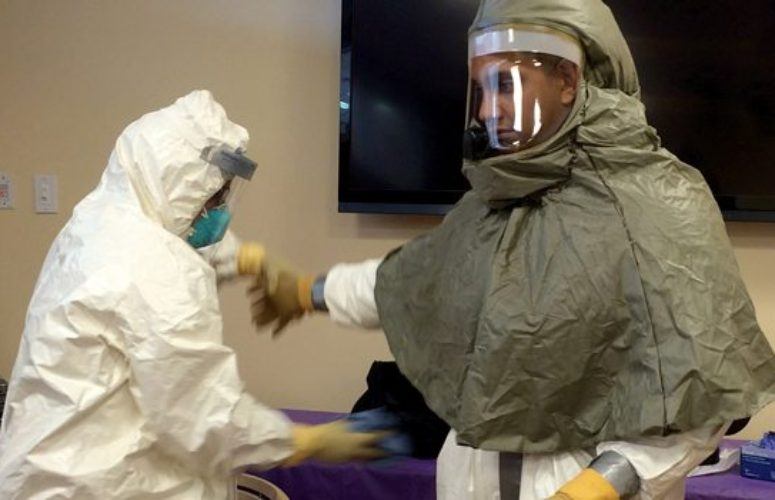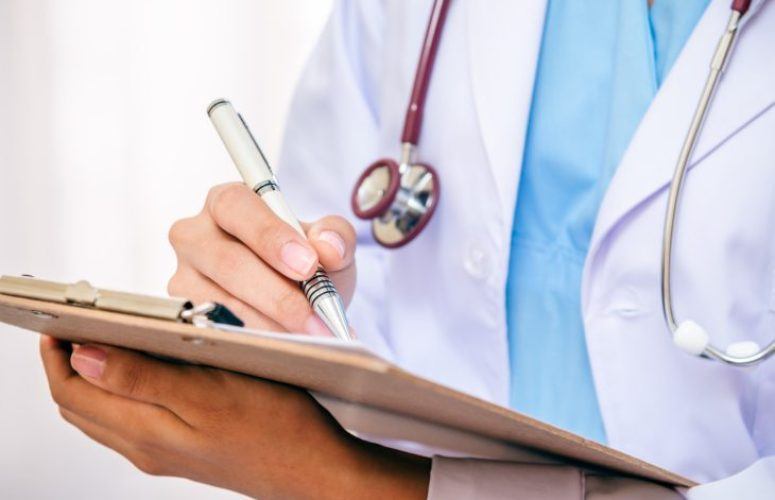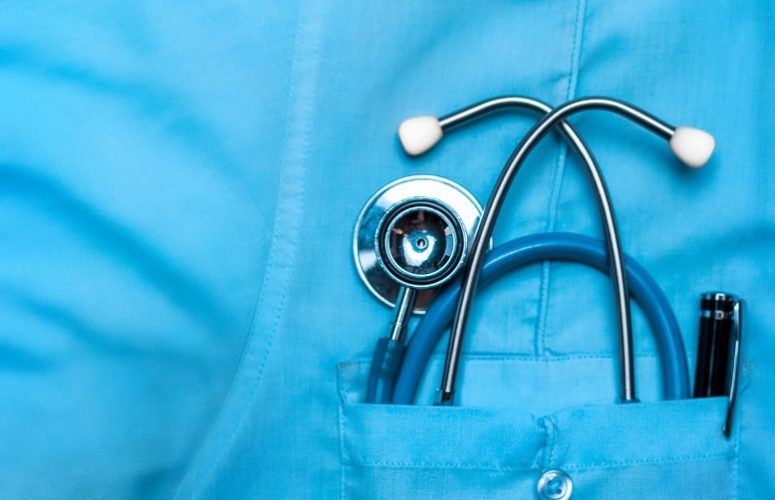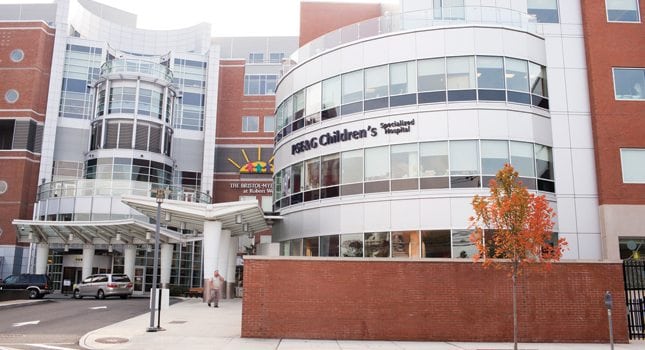
Protecting New Jersey
Hospitals mobilize and collaborate for emergency response.
By Ilene Dorf Manahan, Contributing Writer On Mar 27, 2015Hospitals have always been the go-to sites for emergency care, such as a broken limb, a dangerously high temperature, a heart attack or stroke. But largely since 9/11, hospitals have been ramping up to even higher levels of emergency preparedness that enable them to respond to new iterations of crises and handle threats of mass casualties – whether outbreaks of infectious diseases, weather-related events or terrorism.
At the end of 2014, the Centers for Disease Control and Prevention (CDC) pronounced the top public health challenges for the year. Leading the list were: Ebola, antibiotic resistance and healthcare-associated infections; enterovirus (EV-D68); Middle Eastern Respiratory Syndrome (MERS CoV); HIV/AIDS; and the re-emergence of polio. Earlier this year, measles emerged as a frontline healthcare concern. All are high on the New Jersey healthcare community’s radar screen.
Infectious Diseases
In January, when a health worker arrived at Newark Liberty International Airport with Ebola-like symptoms, she was immediately transferred to Hackensack University Medical Center (HackensackUMC), which, along with University Hospital, Newark, and Robert Wood Johnson University Hospital, New Brunswick, is a primary CDC-designated partner in the state’s Ebola preparedness plan. Individuals exhibiting Ebola-like symptoms are sent to HackensackUMC or University Hospital for assessment as to whether they actually have the disease; treatment (as well as evaluation, if more convenient) is provided by Robert Wood Johnson.
HackensackUMC was alerted prior to the plane landing at Newark Liberty that a passenger was on-board ill with Ebola-like symptoms. The hospital was, therefore, ready to receive her and safely transport her to an isolation room for testing and monitoring. Tests revealed she did not have the disease, but rather a gastrointestinal illness. Following an overnight hospital stay, she was discharged.
“Our staffs are well trained, our plans well thought out and our responses calculated,” reports Joseph Feldman, MD, chairman of HackensackUMC’s Emergency and Trauma Center. Feldman began his medical career during the early days of the AIDS pandemic and suggests there are many parallels in responding to the Ebola outbreak. “You have to study the entire disease process and address that – not just look at the individual patient,” he advises.
“People understandably have been anxious about Ebola and enterovirus,” acknowledges Aline Holmes, RN, New Jersey Hospital Association (NJHA) senior vice president of clinical affairs, who also holds a doctorate in nursing practice (DNP). “But New Jersey residents can rest assured that our hospitals are well prepared to deal with these types of public health threats.” The hospitals have been communicating with each other and working closely with public health authorities at the CDC, the NJ Department of Health and the Ebola Virus Disease Joint Response Team, established by the Christie Administration, to ensure a coordinated and effective response to any possible incidence of infectious disease. Following 9/11, federal and state governments made special funding available for emergency healthcare preparedness – although that has been reduced over the years – and the NJHA created an emergency preparedness office to focus on related planning and implementation issues with its members.
“All of our hospitals are on the watch for Ebola and other infectious diseases, whether by detecting overt symptoms or by directly asking people when they come to the hospital about their inoculations and recent travels,” says Holmes. “Our healthcare professionals can recognize these illnesses, are prepared to care for patients infected with them, and are equipped to isolate patients as needed and help prevent a virus from spreading.”
Holmes emphasizes that Ebola, like HIV/AIDS, is not an airborne disease and is not transmitted through casual contact, which helps limit its spread. It can be contracted only through contact with body fluids or droplets from an individual ill with the virus.
“Conversely, measles and enterovirus are airborne diseases that can spread much more widely. MERS also is an airborne virus,” Holmes says.
“The recent resurgence of measles is an example of how rapidly an infectious disease can spread if it’s airborne,” Dr. Feldman says. “People need to be reminded of the importance of vaccines – whether for measles or polio, which also essentially was eradicated, but with lax inoculation regimens risks re-emerging. Even the annual vaccine against the flu, another airborne disease, while not as effective this year because of the strain’s earlier translation, still provided protection, which resulted in fewer people dying of that virus.” In addition to immunizations, the healthcare community constantly reinforces the need for proper infection control, including frequent hand washing with antibacterial soap, the use of alcohol-based hand sanitizers, containing germs by coughing or sneezing into one’s sleeve and hospital staff wearing appropriate personal protective equipment (PPE).
Hospitals also regularly perform Hazard Vulnerability Analyses (HVAs) to determine the risks to their facilities and region. These risks then are ranked, and policies and procedures are developed, to address the hazards. At Palisades Medical Center (PMC), in North Bergen, for example,
Doreen McSharry, PMC’s director of safety and infection control, reports that as a result of the hospital’s HVA for Ebola, “we determined that our hospital’s proximity to New York and the three major airports significantly increased the possibility of our receiving a confirmed Ebola case and that we needed to be prepared.”
Being prepared included: creating procedures for comprehensive patient screening, including the individual’s travel history and any symptoms of disease; designing a plan for “patient flow” into and through the hospital to placement in an isolation room and upgrading those rooms to meet Ebola standards construction; creating procedures for performing “point of care” (POC) laboratory testing in a patient’s room and cross-training of emergency department nurses to handle that POC testing, which typically is performed by laboratory technicians; and training on properly putting on and taking off PPE, and the containment, disposal and storage of contaminated waste.
Natural and Manmade Disasters
McSharry and PMC also know from experience that being prepared to respond immediately to natural and manmade disasters is as much a priority as being ready to attack infectious diseases. Terrorism experts have referred to the stretch between Newark Liberty International Airport and Port Elizabeth as “the most dangerous two miles in America.” In addition to the airport and port, New Jersey is the most densely populated state in the nation and is the site of numerous chemical plants and refineries, rail lines, including Amtrak, and such major vehicular corridors as the New Jersey Turnpike. With PMC’s strategic location on the Hudson River waterfront and across from Manhattan, the hospital was directly impacted by 9/11, the Miracle on the Hudson landing of US Airways Flight 1549, Hurricane Irene and Superstorm Sandy. PMC was a receiving hospital for victims of 9/11 and passengers of Flight 1549, and chose to evacuate the hospital during both storms.
“Fortunately, even before 9/11, we had applied for and received funding resources from the [federal government]. With some of those dollars, and as a result of our preparedness planning, we – and other hospitals in New Jersey – purchased PPE, which at that time was intended primarily for response to hazardous material spills. When the Ebola crisis erupted, our PPE stockpile was mobilized for that purpose. When the panic was at its peak, PPE was on backorder from key suppliers and not available to other facilities that needed it. Because of our planning, neither we nor many of our region’s other hospitals faced that problem.”
McSharry adds, “Preparing an organization, its staff and its physical plant for an infectious disease response comes at an exorbitant expense. Despite the financial challenges facing hospitals today, our administration supported our Ebola preparedness efforts wholeheartedly and provided the dollars necessary to accomplish our readiness goals. Further, the state Department of Health helped reduce our training costs by conducting (off-site) ‘train the trainer’ sessions that some PMC staff attended. They then trained their colleagues here.”
With seven affiliated hospitals located from Essex and Hudson to Ocean county, Barnabas Health needs to prepare for emergencies that reflect the diversity of the hospitals’ locations, populations and range of services, including ambulatory care, home healthcare and hospice.
“Planning and preparation are integral parts of our culture,” reports Neil Bryant, Community Medical Center vice president of support services and Barnabas Health administrative director of emergency management. “We have a robust infrastructure that is supported by our leadership and significant investment. Our preparedness, post-9/11 to date, has positioned us to respond to current threats such as Ebola.” Recognizing Ebola’s potential impact, Barnabas Health convened a Special Pathogens Team with medical, clinical, infection disease and operations staff to ensure that staff and the public are protected and that its hospitals can care for all patients entering its facilities. “The team has invested in additional equipment and supplies, so we can immediately respond in crisis situations,” Bryant states. “We also continue our staff education and training, mindful that Barnabas Health is trusted and counted on by our patients and communities to support them every day and when an emergency strikes.”
The success of Barnabas Health’s planning was evident during Superstorm Sandy, when the system responded to the floods, fires and total destruction of homes and displacement of residents in southern New Jersey, while northern residents were hit by the hurricane and subsequent snow storm, power outages and fuel shortages. Throughout its service areas, hundreds of residents flocked to the hospitals for warmth, safety, food and electricity to power their cell phones. Moreover, given the high senior population served by its southern hospitals, oxygen concentrators were also sought after.
“As hospitals, we care not only for the ill, but for the ‘worried well,’ who turn to us as a resource in an emergency,” Bryant says. While this is a role that New Jersey hospitals have filled, NJHA’s Holmes emphasizes there needs to be more collaboration with – and support provided by – other community resources to meet emergency needs that are not part of a hospital’s core mission and can seriously drain its resources.
“Let’s face it, our weather and climates have changed, and extreme weather has become a reality of life these days, so we need to drill and be prepared for that,” Dr. Feldman says. “It’s no longer just fingers or feet getting caught in lawn mowers or snow blowers, but heart attacks from snow shoveling or from heat stroke during the more frequent and extreme dog days of summer, plus increased incidence of asthma and COPD. Fortunately, the public is becoming more aware of such secondary, weather-related health effects and is heeding advice on how to avoid them.”
As for public health challenges to come, there are certainly “lurking threats” – from terrorist attacks to bioterrorism to weather and natural events to “infectious diseases that we haven’t encountered and will need to adapt to,” Dr. Feldman predicts. “The key is for us in the medical field to be vigilant and nimble in reacting; we have to collect all the data we can and formulate plans that preserve the integrity of our staffs and institutions so we can continue our mission of protecting the public. The only way for all of us to succeed is to share information and our best practices with each other, as well as with county and local emergency and health-related agencies and organizations.”
“In many ways, Ebola was a wake-up call, reminding everyone how important it is to have a well-prepared healthcare system to respond to these types of threats,” NJHA’s Holmes states, echoing a recurring theme in a December 2014 report, “Outbreaks: Protecting Americans from Infectious Diseases,” from the non-profit Trust for America’s Health and the Princeton-based Robert Wood Johnson Foundation. “True preparedness requires a coordinated effort not just by healthcare providers, but by the entire public health community; we must have a collective commitment to policies and funding that support these efforts. Federal and state grants are only a piece of the puzzle. We must continually seek innovative ways of financing preparedness, medical countermeasures and training for public health workers so they can readily and professionally respond in an emergency.”
Related Articles:






